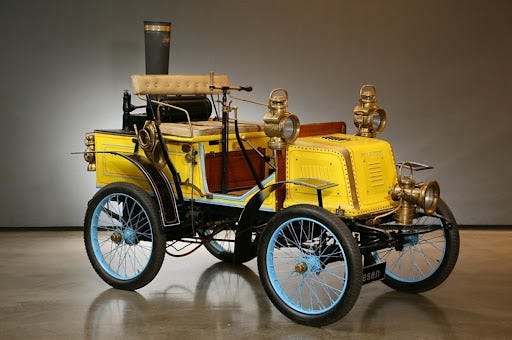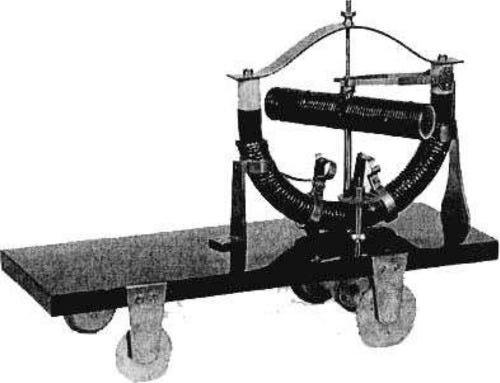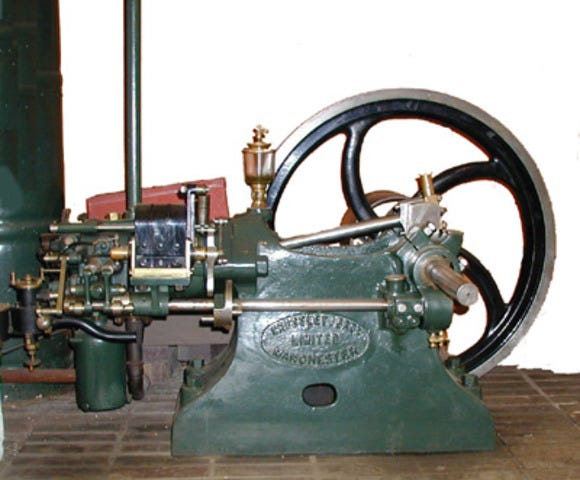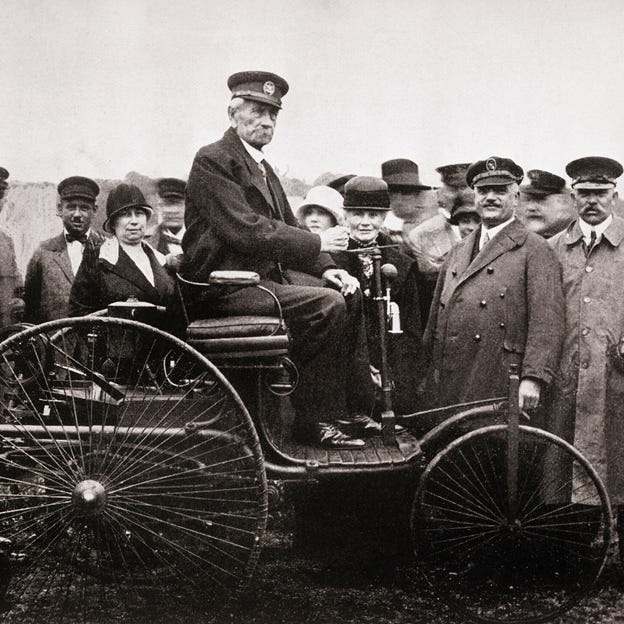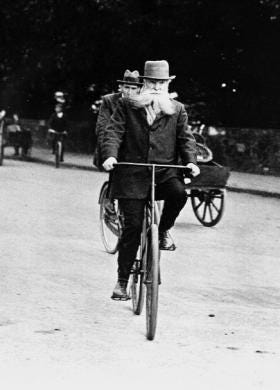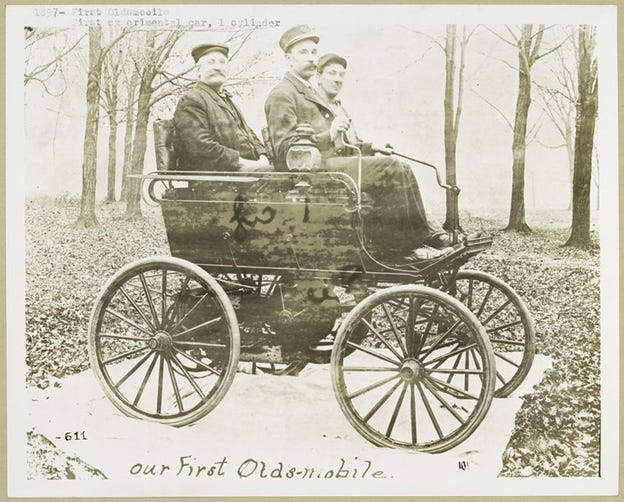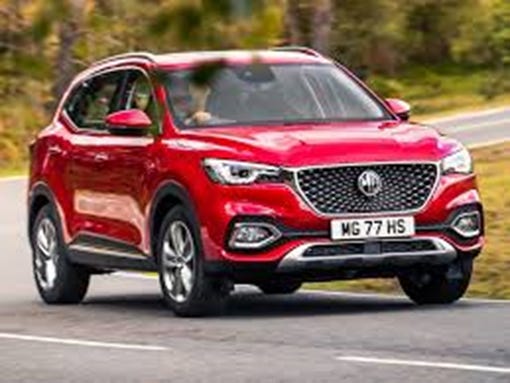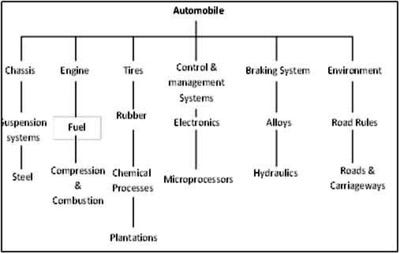From Europe, to the US, Japan, and onto China: The evolution of the automobile
The automobile was not invented by any one individual and was developed from a combination of other inventions and incremental innovations over time
The pre-automobile era
Even though the railways existed in Britain, Europe, and America by the late 1880s, most road transport was still undertaken by house and carriage. There were over three million horses in Britain and ten times that many in America which had to be breed, fed, cared for, and housed. A large amount of farmland was devoted to producing hay and oats for horse feed and it was becoming an expensive exercise to maintain a house and carriage. The industry was reaching the limits to its potential growth by 1900.
The automobile was not invented by any one individual and was developed from a combination of other inventions and incremental innovations over time to create what we know as the automobile today.
One of the first forms of self-propelled automobiles was Cugnot’s steam wagon in 1771 discussed earlier in the steam engine section. This was followed in Britain by William Murdoch’s steam carriage in 1784 and Richard Trevithick’s full size steam vehicle in 1801. However, the British Parliament passed the Locomotive Act (1865) that required any self-propelled vehicles on roads to be preceded by a man on foot with a red flag and blowing a horn, effectively discouraging much more development of the automobile in Britain, where attention was shifted back to the steam engine.
The automobile evolved through incremental invention
Outside Britain there were a number of various vehicles built, some having useful features that would be incorporated into later versions of the automobile. For example, Ivan Kulibin in Russia developed a steam carriage in 1791 that incorporated a flywheel, brake, gearbox, and bearings. In 1805 Oliver Evens, an American developed a self-propelled vehicle that was also an amphibious vehicle. In 1815 Josef Buzek from Prague, from what is now known as the Czech Republic built an oil fired steam car that could run further than other steam vehicles developed until that date due to its more efficient fuel. In 1830s there were also a number of electric cars developed including Anyos Jedlik’s model car powered by his electric motor in 1928, Thomas Davenport’s model electric car in 1834, Stratingh and Becker’s small electric car in 1835, Robert Davidson’s electric car in 1838 that ran on tracks, a forerunner to an electric tram, and Robert Anderson’s electric carriage in 1839.
Anyos Jedlik’s model car powered by his electric motor in 1928
However, steam and electricity were not practical power sources for an automobile, and the absence of a suitable power source hindered commercial development. Likewise, the ride on these early vehicles was very rough due to the wheels being fabricated out of wood or iron. A softer material that could take some shock out of the road was necessary. These problems had to be solved before any commercial vehicle could be invented.
One of the very early concepts of a combustion engine was a water pump driven by gunpowder in the 17th Century to pump water for the Versailles Palace gardens developed by Christiaan Huygens. Shortly after, a number of piston engines utilizing gas were developed. In 1807 a Swiss engineer François Isaac de Rivaz developed an internal combustion engine driven by a hydrogen and oxygen mixture, ignited by an induced spark based on Alessandro Volta’s concept of propulsion using air and hydrogen in a pistol to propel a cork from the end of the barrel from 1790s.
Over the years a number of improvements to the combustion engine were made by Sadi Carnot, Samuel Morey, William Bernett, Eugenio Barsanti and Felice Matteucci, and Pietro Benini. The development of an efficient combustion engine was hindered by the absence of petroleum as a fuel which was just appearing in the later part of the 19th century.
Around 1860 the Belgian Etienne Lenoir developed a gas fueled electrically ignited internal combustion engine that utilized cylinders, pistons connected to rods and a flywheel where the gas basically took the place of steam, as in the Watt steam engines. The engine was commercially produced and used extensively to drive stationary machinery. Although the Lenoir engine attracted much publicity, it was not suitable for a moving vehicle but inspired others to refine and develop upon the basic design.
Etienne Lenoir’s combustion engine
One of these people was Nikolaus August Otto who thought that running the engine on gas was impractical and imagined an engine running on the vapour of petrol mixed with air. Together with a friend Michael Zons who had a workshop, they built a small engine that ran on alcohol and applied for a patent that stipulated an engine that would propel vehicles serviceably along a country road[1]. The patent application was turned down on the basis that the engine was too close to others, so Otto and Zons continued to development until they created a four-stroke cycle engine. That year Otto formally joined Zons in his machine shop and went across to London to see if anybody else was offering any similar types of engines. He found that nobody else had anything like it.
Otto had a number of ideas to make the engine more efficient but was starting to run out of money. He eventually met up with a young engineer Eugene Langen from a wealthy family who became a partner and bankrolled Otto, forming N.A. Otto & Company, engine builders. After selling a few engines they found that in their present form the engine was not too saleable and spent the next three years experimenting until they created an engine with a vertical cylinder and piston connected to a cog wheel that went up and down. They presented it at the Great Exhibition in Paris during 1867. It just so happened that one of Otto’s old acquaintances Professor Franz Reuleaux of Berlin University was on the judging committee and insisted Otto’s engine be directly compared to the Lenoir engines on display. The judges found that the Otto engine used only one third the fuel used by the Lenoir engine and Otto and Langen won the gold medal personally presented to them by Napoleon III. After the exhibition sales increased dramatically and by 1871, they had licensed production of the engine to Crossley Brothers of Manchester and were making profits. The company continued to grow and took on some new partners and was renamed Deutz-AG-Gasmotorenfabrik.
Gottlieb Daimler was interested in building an automobile from an early age. He showed himself to be a very skilled craftsman during his apprenticeship at a gunsmith workshop and was awarded a place at the School for Advanced Training in Stuttgart where he studied at night while working during the day. Daimler later moved to Strasbourg where he worked on steam locomotives and built railway cars, becoming foreman at the age of 22. He was given leave to study at the Stuttgart Polytechnic Institute and completed the four year course in two years. Daimler then spent some time in Paris and Britain where he toured and worked at a number of engineering works. He also attended the 1862 Great Exhibition in London. Upon his return to Germany Daimler spent a few years working at the Bruderhaus Factory producing machines for paper mills, farms, and weighbridges. During his time at Bruderhaus, Daimler met Wilhelm Mayback with whom he developed a very close relationship. Maybach was a very creative draughtsman who was later to follow Daimler from job to job.
Daimler was approached by Langen in 1872 to work for Deutz which was expanding their production of the Otto engine. Daimler persuaded Langen to also take on Mayback as chief designer for the company. They both spent about ten years at Deutz, with Daimler leaving to set up his own company in Cannstatt from the compensation he got from Otto for his work on the patents. Maybach soon joined him and they set out to produce a petrol engine that had an efficient and quick starting ignition and a power-to-weight ratio that would be suited for an automobile. By 1885 they had produced a one horsepower engine with some improvements over the Otto engine including a carburetor to mix fuel with the air for better combustion. Daimler fixed an engine to a bicycle and created the first powered motorcycle. Daimler also bought a carriage he bought from Stuttgart and mounted the engine onto it as a “present to his wife”.
Quite independently Karl Friedrich Benz was also working on a petrol engine. Benz was born into a relatively poor family but was able to get a good education where he studied locomotive engineering at university. During these years Benz had a dream of building a self-propelled horseless carriage. Benz started his first business a machine shop and supplier of construction materials in 1871 with a partner August Ritter. The company ran into financial trouble and Benz fiancée Bertha Ringer bought out Ritter with money from her dowry. After further poor business performance the firm got into further financial trouble where Benz admitted a new partner and lost control of the company. In 1883 Benz left the company and bought into a bicycle repair shop in Mannheim with Max Rose and Friedrich Wilhelm Eβlinger.
Benz soon left and went into the engine building business and formed Benz & Cie Rheinsche Gasmotoren-Fabrik. The business went well producing engines for a growing market and this gave Benz the opportunity to focus his attention on building an automobile. Benz developed an automobile primarily based on bicycle technology. It was powered by a four-stroke engine Benz had designed, sitting between the rear wheels with the power being transmitted through chains to the rear axle. Benz patented his automobile in 1886 calling it the Benz Patented Motorwagen. This first model had plenty of room for improvement and Benz over successive years created new versions that ironed out faults in the previous model. Although his invention had plenty of attention, there was actually little interest in purchasing the vehicle. Most of the sales were in France through Benz’s agent Emile Roger, who was already building Benz engines under license there.
There were still a number of problems. Gasoline at the time was only sold by pharmacies as a cleaning fluid, and the automobile still lacked power to climb small hills and the brakes were rough. The automobile could not go in reverse. An important event in the history of Benz was the story of Bertha Benz in 1888 using the car to travel from Mannheim to Pforzheim to visit her mother, a round trip of some 212 km. During the trip she apparently made some technical improvements to the automobile which included putting leather brake linings on the brakes to help with downhill braking and recommended to her husband to add another gear to the engine so it could go up hills better.
By 1895 the Benz factory had sold more than 135 cars and was known as one of the most important manufacturer of automobiles[2]. Now Germany had three manufacturers of petrol engines.
Karl Benz and the first commercial automobile
The early bicycles and automobiles used wooden or iron rims for tyres which had no shock absorbing properties. However, for the tyre to be invented, a pliable material that could be used in its construction was required. Charles Goodyear heard about the properties of gum elastic[3] and went to see J. Haskins, the manager of Roxbury Rubber Company in New York. Goodyear found that the rubber used to make products disintegrated over time rendering them useless. He started working with Indian rubber by heating it and adding different materials in attempts to get the stickiness out of the material. Goodyear thought that he found the solution using an acidic material to cure the latex and built up a business manufacturing life preservers, rubber shoes, and other rubber based products. Due to the crash of 1837, Goodyear became penniless and it was only the financial support given to him by J. Haskins who he knew at Roxbury Rubber Company that saved him. Goodyear continued to experiment to improve the curing process. In 1838 Goodyear met with Nathaniel Hayward who had been using sulphur to dry rubber. Goodyear found that when rubber was heated with sulphur, the rubber cured perfectly–heating sulphur with rubber created vulcanized rubber, named after the Greek god of fire. It is debated today whether Goodyear found the solution by pure luck or through careful application and observation. Goodyear made the discovery in 1839 but only patented it in 1844 after he enhanced and fine-tuned the process. Vulcanized rubber could be utilized to make many products of which automobile tyres was one of them.
Robert William Thomson was born in Stonehaven, Scotland and moved to America at the age of 14 where he was apprenticed to a merchant. Two years later he returned to Scotland teaching himself chemistry, electricity, and astronomy. Robert’s father built him a workshop where he improved upon his mother’s washing mangle so wet linen could be passed through, designed a ribbon saw, made a working model of an elliptic steam engine, and a number of other inventions. He set up his own railway consulting company, while he designed and built a pneumatic tyre for horse carriages. The tyre consisted of a hollow India rubber and canvas tube inflated with air enclosed in a strong leather casing of leather and bolted to the wheel. The wheels formed a cushion of air upon the road or track they ran on which greatly improved the comfort of travel and reducing the noise. One set of tyres lasted for more than 1,200 miles. Thomson patented the tyre in France in 1846 and in America in 1847.
Thomson’s invention basically went unnoticed and forty years and forgotten. A Scottish veterinary surgeon John Boyd Dunlop came up with the idea again as a way to improve the suspension of carriages. Dunlop had worked with sheets of rubber at his surgery and first made a pneumatic tyre for his son’s tricycle from wrapping the sheet into a hollow lined with linen that he blew up with his son’s football pump. After finding that bicycles with pneumatic tyres were much faster than existing tyres at the time, the bicycle fraternity in Ireland switched over to them and in 1889 Dunlop formed a company with Harvey du Cros, President of the Irish Cyclists Association. On filing a patent application, Dunlop’s claim to novelty was invalidated by Thomson’s prior patent. Other aspects of the tyre were patented and Dunlop assigned his patent over to Harvey du Cros and du Cros formed the Dunlop Rubber Company of which Dunlop had no interest. Dunlop had reinvented the pneumatic tyre, unlike in Thomson’s time, at a crucial time in the development of road transport.
John Boyd Dunlop invented the pneumatic tyre
At about the same time Dunlop was producing tyres in Ireland, Edouard and André Michelin in France were running a rubber factory in France. The company produced rubber balls and invented rubber brake pads for horse-drawn carriages. There are a number of stories about how the Michelin brothers started making tyres but one story tells of how the Grand Pierre asked for help at the Michelin workshop to repair one of his pneumatic tyres on the bicycle[4]. According to this story the tyre was glued to the wheel rim and it took hours to remove it and all night for the glue to dry after it was repaired. Edouard saw the need to have pneumatic tyres that could be easily removed from wheel rims for repairs. From 1891 the Michelin brothers began manufacturing tyres where France became the number one tyre maker in the world until the end of the century.
A number of companies ventured into automobile manufacturing in Europe and the automobile started replacing the bicycle and horse and carriage. After lobbying British restrictions on automobiles were lifted and the industry flourished. Motor buses and trucks began appearing changing public and goods transport. With the petroleum industry established in the United States and large distances to travel the automobile very quickly became popular with the likes of Charles and Frank Duryea forming the Duryea Motor Company, Ransom E Olds forming the Olds Motor Vehicle Company, and the eventual formation of the Ford Motor Company that was going to take automobiles onto a new plain in the new Millennium.
The transition to Chinese dominance
The decade saw the rise of the fourth generation of modern automobile manufacturers, the first being the US automakers, then the Japanese emergence in the 1960s and 70s, and then the Korean emergence during the 1990s. The fourth Generation consists of Indian manufacturers like Tata Motors and a number of newly created Chinese manufacturers which include BYD, Lifan, Chang’an (Chana), Geely, Cheri, Hafei, Great Wall, Jianghuai (JAC), Roewe, Martin and a number of others.
Tata Motors is part of the Tata Group, the largest privately owned conglomerate in India. Tata began operations in 1945 building locomotives and then in 1954 commenced manufacturing commercial vehicles as a joint venture with Daimler-Benz. Tata entered the passenger car market in 1991 launching the Tata Sierra and a number of other models. In 1998 Tata launched the Indica, the first fully indigenous car built in India which was a great success and now exported to South Africa, the United Kingdom, and Italy. The company acquired Daewoo truck manufacturing operation in 2004, a controlling interest in Aragonese (within Spain) Hispano Carrocera in 2005, formed a joint venture with Marcopolo in Brazil in 2007, acquired British Jaguar land Rover in 2008 and took an 80% stake in Trilix of Italy in 2010. In 2008 Tata launched the Nano, a car priced around USD $2,000 so that more people could afford to purchase an automobile in India. Tata is experimenting with electric cars and compressed air engines. Today Tata has an extremely strong customer based on the Sub-continent and exports to 26 countries with manufacturing plants in the UK, Korea, Spain, Thailand, South Africa, and Argentina. Under franchise Tata cars are also assembled in Russia, Ukraine, Kenya, Bangladesh, and Senegal.
China’s auto industry began in the 1950s under the guidance of the Chinese Communist Party Central Committee, with technical assistance from the Soviet Union. From the 1980s to 2000 all of the China’s leading automakers were joint ventures with foreign automobile companies. Output was tightly controlled with most production focused on commercial vehicles. As China prospered, vehicle ownership has increased dramatically, where production increased from one million automobiles in 2000 to almost 14 million vehicles in 2009[5], making China the largest automobile manufacturer in the world[6].
Many of the local companies that commenced operations after the 1990s were owned by the Defense Ministry, Chang’an Motors, Changhe, Hufei Motors, or provincial authorities, Brilliance China Auto, Cherry Auto, and Chang Feng Automotive. A few private companies BYD Auto, Greely Automotive and Great Wall Motors also started up. On the whole Chinese automakers lack the efficiency and quality, but still produce cars much cheaper than manufacturers in other countries. R&D is still low at present with some companies taking inspiration from international models. The state-owned Cherry Automobile Co. Ltd. is the largest independent domestic vehicle manufacturer and will be privatized soon. Some of the other major domestic manufacturers First Automobile Works Group Corporation (FAW), Greely, SAIC, and Dong Feng have built their cars upon platforms provided from international automakers while the rest have been the result been built from knowledge gained through reengineering or just outright copying[7]. Some firms like SAIC and Nanjing Automobile Group acquired MC Rover to access technology and there is a tendency for domestic companies to acquire international brands rather than build them[8]. The Chinese Government is encouraging domestic automakers to merge so that three or four main domestic players exist in the industry[9]. Due to the economic downturn of 2008 Chinese Automakers had been able to acquire struggling part manufacturers such as the Greely purchase of the Australian Drivetrain Systems International (DSI).
The iconic British MG now owned by Chinese interests
Chinese companies are working on developing electric cars. However, costs are still too high for the average Chinese consumer, and there are still many practical problems as most Chinese live-in apartments and access to power supplies may be difficult. Nevertheless, China is the largest producer of electric cars in the world. One company committed to the development of electric cars is BYD, a Shenzhen based company founded by entrepreneur Wang Chuanfu in 1995 when he was 29 years old[10]. By 2005 BYD was the largest manufacturer of batteries in the world for mobile phones, iPods, digital cameras, and other electronic goods. While he still eats in the company canteen and lives in the company housing block, Wang Chuanfu is now considered one of the richest people in China[11]. Warren Buffet is an investor in BYD.
As we can see the invention of the automobile was built upon a number of foregoing pieces of new knowledge and inventions in various domains that filled in the missing links that make the invention possible. Until every aspect of knowledge and sub-component exists that is required for the invention to take form, it cannot take form. For example. an automobile is a compilation of numerous previous inventions that enable the form of an automobile to exist. Without the ideas of steel, rubber, fuel, concepts of compression and combustion, electronics, tires, braking systems, new alloys, hydraulic systems, road rules and carriageways, the automobile cannot exist (see Figure 1).
Figure 1. The hierarchy of inventions that make the invention of the automobile possible[12]
The creation of inventions that become incorporated into what we call the automobile was and still is a continuous process, making incremental improvements to the whole idea and concept. New composite polymer materials and plastics make lighter frames without sacrificing strength, new engine power enhancing systems like turbochargers and fuel injection systems contribute to the enhancement of car performance. The automobile is a system of ideas and also forms part of other idea systems like transport and city planning, etc.
Any new technology like the automobile brings with it a number of new opportunities in addition to the original intended purpose of the technology. The advent of the automobile industry enabled the formation and development of many specialized service businesses, and satellite suppliers of car parts for production. The automobile has led to automobile service stations, parts manufacturers, paint manufacturers, steel suppliers, logistic transport providers, and automobile dealers, as well as the invention of seat beats and other safety equipment. The development of cities like Detroit in the 1950s was driven by the auto industry.
The automobile also radically changed the way societies existed. Auto manufacturing clusters are also a feature in the development of a nation, as we have seen in Britain, Europe, the US, Australia, Japan, Korea, Malaysia, and of late India and China - rising, stagnating, and eventually declining. Some of these early industries may grow out of factor advantages such as low-cost labour, as did the Japanese consumer product manufacturing during the 1950s and 1960s. However, to maintain any industry in the long term, a new basis of competitive advantage should be developed on the production and/or market sides, i.e., new technologies, design superiority, the development of enhanced logistical chains, or the targeting of special market segments like the Japanese did with small automobiles, etc.
Now we are again witnessing a change in the guard of this industry towards China.
Originally published in OVI Magazine 12th October 2012
You can subscribe for free emails of future articles here:
[1]Diesel, E., Goldbeck, G., & Schildberger, F. (1960). From Engines to Autos: Five pioneers in engine development and their contributions to the auto industry, Chicago, Henry Regnery Company
[2] Weightman, G. (2007). The Industrial Revolutionaries: The making of the modern world, 1776-1914, New York, Grove Press, P. 320.
[3] Natural rubber derived from latex.
[4] Lottman, H.R. (2003). The Michelin Men Driving and Empire, London, I.B. Tauris.
[5] See: Motoring Ahead: More Cars are Sold in China than in America, The Economist, 23rd October 2009, http://www.economist.com/node/14732026?story_id=14732026&fsrc=nwl, (accessed 16th February 2011).
[6] Marr, K. (2009). As Detroit Crumbles, China Emerges as Auto Epicenter, The Washington Post, 18th May, http://www.washingtonpost.com/wp-
dyn/content/article/2009/05/17/AR2009051702269.html, (accessed 15th February 2011).
[7] Tang, R. (2009). The Rise of China’s Auto Industry and its Impact on the U.S. Motor Vehicle Industry, Washington D.C., Congressional Research Service, P. 13,
http://www.fas.org/sgp/crs/row/R40924.pdf, (accessed 15th February 2011).
[8] Jian, Y. (2009). Chinese Car Companies Resort to Buying Brands Rather Than Creating Them, Advertising Age, 15th July, http://adage.com/china/article?article_id=137900, (accessed 16th February 2011).
[9] Tang, R. (2009), P. 14.
[10] Wang Chuanfu: Building electric dreams in China, CNN.com/asia, 20th April 2009, http://edition.cnn.com/2009/WORLD/asiapcf/04/20/byd.wangchuanfu/index.html, (accessed 14th February 2011).
[11] See: http://www.forbes.com/lists/2010/10/billionaires-2010_Wang-Chuanfu_39SU.html
[12] Hunter, M. (2012), Opportunity, Strategy, & Entrepreneurship: A Meta-Theory, Vol. 1., New York, Nova Science Publishers, P. 53.




